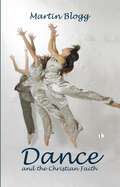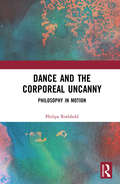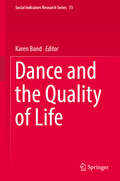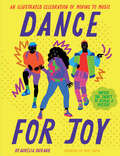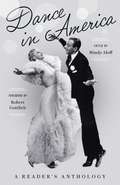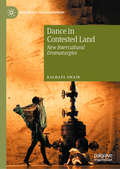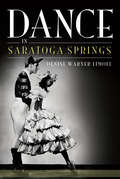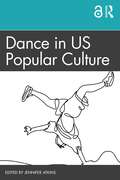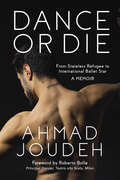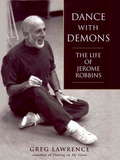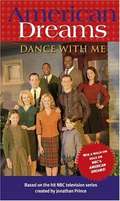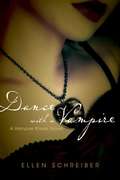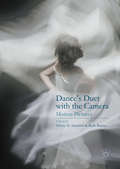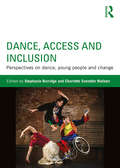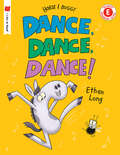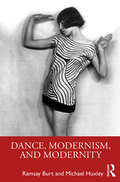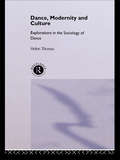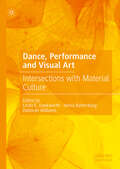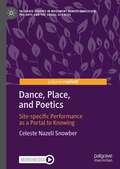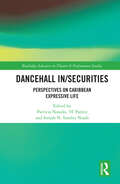- Table View
- List View
Dance and the Christian Faith: A Form of Knowing
by Martin BloggFirst published in 1985, this pioneering work on religious dance was written in response to the paradoxical attitude of many Christians who express an interest and enthusiasm for the arts as part of Christian worship, yet retain a suspicion, even a dislike, of dance. Dance and the Christian Faith examines what the bible says about both dance and worship, and relates it to an understanding of what dance is and how it can be used in the church and in education today. Martin Blogg relates his faith to his profession of teaching dance drama and his non-verbal approach to Christian dance opens up new avenues for the expression of the faith, complementing the more traditional forms of speech, music and sacrament. The book is a critical discussion, both theoretical and practical, of the nature and conditions of religious dance, as explored through the disciplines of scripture, education and dance as art. At the same time, Dance and the Christian Faith is a call for Christians to embrace dance as a means to prayer and worship, outreach and renewal. Although centred on dance within a religious context, much of the discussion is directly relevant to dance education and the performing arts in general. With a Foreword by the Rt Revd Maurice Wood, former Bishop of Norwich.
Dance and the Corporeal Uncanny: Philosophy in Motion
by Philipa RothfieldDance and the Corporeal Uncanny takes the philosophy of the body into the field of dance, through the lens of subjectivity and via its critique. It draws on dance and performance as its dedicated field of practice to articulate a philosophy of agency and movement. It is organized around two conceptual paradigms - one phenomenological (via Merleau-Ponty), the other an interpretation of Nietzschean philosophy, mediated through the work of Deleuze. The book draws on dance studies, cultural critique, ethnography and postcolonial theory, seeking an interdisciplinary audience in philosophy, dance and cultural studies.
Dance and the Quality of Life (Social Indicators Research Series #73)
by Karen BondThis is the first volume devoted to the topic of dance and quality of life. Thirty-one chapters illuminate dance in relation to singular and overlapping themes of nature, philosophy, spirituality, religion, life span, learning, love, family, teaching, creativity, ability, socio-cultural identity, politics and change, sex and gender, wellbeing, and more. With contributions from a multi-generational group of artists, community workers, educators, philosophers, researchers, students and health professionals, this volume presents a thoughtful, expansive-yet-focused, and nuanced discussion of dance’s contribution to human life. The volume will interest dance specialists, quality of life researchers, and anyone interested in exploring dance’s contribution to quality of living and being.
Dance for Joy: An Illustrated Celebration of Moving to Music
by Aurelia DurandA vibrantly illustrated and inclusive celebration of dance in all its styles, moods, and meanings. Dance can be radical self-expression, community celebration, revolutionary protest, or pure elation. Whether you're a professional ballet dancer or the first person on the dance floor at parties, whether you dance in your living room or out in the streets, you know the power of moving to music. Artist and author Aurélia Durand bottles the lightning of dance in these vibrantly illustrated pages. You're invited to embark on a world tour of styles, explore a who's-who of iconic and inspiring dancers, and celebrate all the amazing ways movement can make you feel: empowered, fabulous, free. With joyful affirmations and playful interactive content, this book brings together culture, history, and neon illustrations that practically dance off the page. A foreword by popular jam skater Oumi Janta reflects on the magic of Durand's artwork. This is for anyone who feels a rhythm and the need to move with it. STAR ILLUSTRATOR: From illustrating the New York Times-bestselling This Book Is Anti-Racist, to delivering a keynote slot at Adobe Max, Aurélia Durand captures the zeitgeist in bold shape and color. She’s an ambitious and multitalented artist, poised to move hearts and minds with her first authored book and an accompanying stationery line. INCLUSIVE AND EMPOWERING MESSAGE: This book weaves together movement traditions from around the world, offering a truly inclusive vision, and highlights all the ways that dance intersects with liberation and empowerment. A NEW GENERATION OF DANCERS: Online platforms like Tiktok have ushered in a new era for dance, with challenges going viral and new styles being shared around the world. Durand's uplifting images are perfectly pitched for those who have discovered a new passion for expressing themselves through movement online. Perfect for:Dancers and dance loversAurélia Durand and Oumi Janta fansPeople passionate about inclusivity and joyful activismPeople seeking to celebrate Black excellenceCreatives of all typesFans of Tiktok dance videos
Dance in America: A Library of America Special Publication
by Robert Gottlieb Mindy AloffFrom ballet and Balanchine to tap and swing, a treasury of unforgettable writing about the beauty and magic of American dance.From the beginning, American dance has been an exciting fusion of many disparate influences, with European traditions of ballet and social dancing encountering Native American rituals and African American improvisations to create something new and extraordinary. In this landmark collection, dance critic Mindy Aloff brings together an astonishing array of writers—dancers and dance creators, impresarios and critics, and enthusiastic literary observers—to tell the remarkable story of the artistry, innovation, and sheer joy of a great American art form. Here is dance in its many varieties and locales: from tap and swing to ballet and modern dance, from Five Points to Radio City Music Hall, and from the Lindy Hop to Michael Jackson’s Moonwalk. With 100 selections spanning three centuries, this is the biggest and best anthology on American dance ever published. Here are the most acclaimed dance critics, including Edwin Denby, Joan Acocella, Lincoln Kirstein, Jill Johnston, and Clive Barnes; the most inventive and influential choreographers and dancers, among them George Balanchine, Merce Cunningham, Paul Taylor, Twyla Tharp, Allegra Kent, and Mikhail Baryshnikov; and a dazzling roster of literary figures, such as Ralph Waldo Emerson, Emily Dickinson, Hart Crane, Edmund Wilson, Langston Hughes, and Susan Sontag. Here too are rare and hard-to-find texts, several previously unpublished, among them Jerome Robbins’s reflections on the secret of choreography and an inspiring commencement address from Mark Morris. Brilliant profiles of unforgettable performers—Stuart Hodes on Martha Graham; John Updike on Gene Kelly; Alastair Macaulay on Michael Jackson—join incisive, often deeply personal pieces—Zora Neale Hurston on hoodoo ritual; Arlene Croce on dance in film; Yehuda Hyman on Hasidic dances—to form a one-of-kind reading experience every dance lover will cherish. A twelve-page color insert presents iconic photographs of key figures from Isadora Duncan to Michael Jackson.
Dance in Contested Land: New Intercultural Dramaturgies (New World Choreographies)
by Rachael SwainThis book traces an engagement between intercultural dance company Marrugeku and unceded lands of the Yawuru, Bunuba, and Nyikina in the north west of Australia. In the face of colonial legacies and extractive capitalism, it examines how Indigenous ontologies bring ecological thought to dance through an entangled web of attachments to people, species, geologies, political histories, and land. Following choreographic interactions across the multiple subject positions of Indigenous, settler, and European artists between 2012–2016 the book closely examines projects such as Yawuru/Bardi dancer and choreographer Dalisa Pigram’s solo Gudirr Gudirr (2013) and the multimedia work Cut the Sky (2015). Dance in Contested Land reveals how emergent intercultural dramaturgies can mediate dance and land to revision and reorientate kinetics, emotion, and responsibilities through sites of Indigenous resurgence and experimentation.
Dance in Saratoga Springs
by Denise Warner LimoliKnown to aspiring dancers and ballet enthusiasts worldwide, Saratoga Springs is much more than the home of the National Museum of Dance. The arts have always been nurtured in the Spa City, and in 1964, the world-famous founder of the New York City Ballet, George Balanchine, decided to make the new Saratoga Performing Arts Center his company's summer home. The company has brought some of the world's most famous dancers and choreographers to Saratoga ever since. Skidmore College offered one of the best dance programs in the nation, and several prestigious academies and summer programs have made Saratoga their home, helping young people from Lake Avenue and around the world achieve that illustrious dream of dancing professionally. Skidmore dance professor Denise Warner Limoli narrates this beautiful history, from turn-of-the-century "floral fetes" to today's vibrant dance community.
Dance in US Popular Culture
by Jennifer AtkinsThis innovative textbook applies basic dance history and theory to contemporary popular culture examples in order to examine our own ways of moving in—and through—culture. By drawing on material relevant to students, Dance in US Popular Culture successfully introduces students to critical thinking around the most personal of terrain: our bodies and our identities. The book asks readers to think about: what embodied knowledge we carry with us and how we can understand history and society through that lens what stereotypes and accompanying expectations are embedded in performance, related to gender and/or race, for instance how such expectations are reinforced, negotiated, challenged, embraced, or rescripted by performers and audiences how readers articulate their own sense of complex identity within the constantly shifting landscape of popular culture, how this shapes an active sense of their everyday lives, and how this can act as a springboard towards dismantling systems of oppression Through readings, questions, movement analyses, and assignment prompts that take students from computer to nightclub and beyond, Dance in US Popular Culture readers develop their own cultural sense of dance and the moving body’s sociopolitical importance while also determining how dance is fundamentally applicable to their own identity. This is the ideal textbook for high school and undergraduate students of dance and dance studies in BA and BfA courses, as well as those studying popular culture from interdisciplinary perspectives including cultural studies, media studies, communication studies, theater and performance studies.
Dance of the Swan: A Story about Anna Pavlova
by Barbara AllmanA biographical account of the life of Anna Pavlova, the famous ballerina.
Dance on the Historically Black College Campus: The Familiar and the Foreign (The Arts in Higher Education)
by Wanda K. EbrightThis volume explores the history of dance on the historically black college and university (HBCU) campus, casting a first light on the historical practices and current state of college dance program practice in HBCUs. The author addresses how HBCU dance programs developed their institutional visions and missions in a manner that offers students an experience of American higher education in dance, while honoring how the African diaspora persists in and through these experiences. Chapters illustrate how both Western and African diaspora dances have persisted, integrated through curriculum and practice, and present a model for culturally inclusive histories, traditions, and practices that reflect Western and African diasporas in ongoing dialogue and negotiation on the HBCU campus today.
Dance or Die: From Stateless Refugee to International Ballet Star A MEMOIR
by Ahmad JoudehA Syria-born dancer offers his deeply personal story of war, statelessness, and the pursuit of the art of dance in this inspirational memoir. DANCE OR DIE is an autobiographical coming-of-age account of Ahmad Joudeh, a young refugee who grows up in Damascus with dreams of becoming a dancer. When he is recruited by one of Syria&’s top dance companies, neither bombs nor family opposition can keep him from taking classes, practicing hard, and becoming a Middle Eastern celebrity on a Lebanese reality show. Despite death threats if Ahmad continues to dance, his father kicking him out of the house, and the war around him intensifying, he persists and even gets a tattoo on his neck right where the executioner's blade would fall that says, "Dance or Die." A powerful look at refugee life in Syria, DANCE OR DIE tells of the pursuit of personal expression in the most dangerous of circumstances and of the power of art to transcend war and suffering. It follows Ahmad from Damascus to Beirut to Amsterdam, where he finds a home with one of Europe's top ballet troupes, and from where he continues to fight for the human rights of refugees everywhere through his art, his activism, and his commitment to justice.
Dance to the Piper
by Joan Acocella Agnes De MilleBorn into a family of successful playwrights and producers, Agnes de Mille was determined to be an actress. Then one day she witnessed the Russian ballet dancer Anna Pavlova, and her life was altered forever. Hypnotized by Pavlova's beauty, in that moment de Mille dedicated herself to dance. Her memoir records with lighthearted humor and wisdom not only the difficulties she faced--the resistance of her parents, the sacrifices of her training--but also the frontier atmosphere of early Hollywood and New York and London during the Depression. "This is the story of an American dancer," writes de Mille, "a spoiled egocentric wealthy girl, who learned with difficulty to become a worker, to set and meet standards, to brace a Victorian sensibility to contemporary roughhousing, and who, with happy good fortune, participated by the side of great colleagues in a renaissance of the most ancient and magical of all the arts."
Dance with Demons: The Life of Jerome Robbins
by Greg LawrenceDance with Demons is the first full biography of the celebrated choreographer/director of Broadway, ballet, and Hollywood - a man of towering achievement and extraordinary personal nightmares. For decades, he was one of the most commanding creative forces in America. His work on such shows as On the Town, The King and I, West Side Story, Fiddler on the Roof, Gypsy, Peter Pan, and Jerome Robbins' Broadway earned him five Tony Awards and two Academy Awards. His brilliance with American Ballet Theatre and the New York City Ballet established him as one of the century's great choreographers. But when Jerome Robbins, ne Rabinowitz, died at the age of seventy-nine in 1998, he was a haunted man. All of his life, he had struggled with demons: his bisexuality, his ambivalence about his Judaism, his often bitter relationship with his parents, his betrayals of others during the McCarthy hearings, and a fear of failure that drove him to a perfectionism bordering on the sadistic. Dance with Demons is is the story that Robbins was unable to tell. Based on years of research and interviews with hundreds of Robbins's family, friends, and colleagues, it gives the full measure of both the artist and the man. Filled with stories and voices, it is a fascinating portrait of light and dark - like its subject, a work rich in complexity.
Dance with Me (American Dreams)
by Emily OzMeg Pryor wants to dance on American Bandstand more than anything else in the world. Luckily her best friend, Roxanne, knows how to work it! She not only manages to get them in, but the two of them dance their way into regular spots on the show. It's a dream come true... that is until Meg's dad finds out and forbids her to go back. Trying to convince Jack Pryor of anything is a tall order -- even for Meg's mom and older brother. But her passion for music and dancing eventually prevail and his resolve is softened. Being on "American Bandstand" opens up a whole new world for Meg. She gets to see amazing live bands, dance with cute boys, and everyone at school is envious that she's on the show. The only person who isn't impressed is Luke Foley. He works at the Vinyl Crocodile, worships Bob Dylan, and finds the whole Bandstand thing ridiculous. It's a good thing she doesn't like him at all...or does she?
Dance with a Vampire (Vampire Kisses #4)
by Ellen SchreiberRaven tries to shield her younger brother from the menacing Valentine Maxwell, even as she yearns to attend the prom with her immortal love, Alexander.
Dance's Duet with the Camera: Motion Pictures
by Telory D. D. Arendell Ruth BarnesDance's Duet with the Camera: Motion Pictures is a collection of essays written by various authors on the relationship between live dance and film. Chapters cover a range of topics that explore dance film, contemporary dance with film on stage, dance as an ideal medium to be captured by 3D images and videodance as kin to site-specific choreography. This book explores the ways in which early practitioners such as Loïe Fuller and Maya Deren began a conversation between media that has continued to evolve and yet still retains certain unanswered questions. Methodology for this conversation includes dance historical approaches as well as mechanical considerations. The camera is a partner, a disembodied portion of self that looks in order to reflect on, to mirror, or to presage movement. This conversation includes issues of sexuality, race, and mixed ability. Bodies and lenses share equal billing.
Dance, Access and Inclusion: Perspectives on Dance, Young People and Change
by Charlotte Svendler Nielsen Stephanie BurridgeThe arts have a crucial role in empowering young people with special needs through diverse dance initiatives. Inclusive pedagogy that integrates all students in rich, equitable and just dance programmes within education frameworks is occurring alongside enabling projects by community groups and in the professional dance world where many high-profile choreographers actively seek opportunities to work across diversity to inspire creativity. Access and inclusion is increasingly the essence of projects for disenfranchised and traumatised youth who find creative expression, freedom and hope through dance. This volume foregrounds dance for young people with special needs and presents best practice scenarios in schools, communities and the professional sphere. International perspectives come from Australia, Brazil, Cambodia, Canada, Denmark, Fiji, Finland, India, Indonesia, Jamaica, Japan, Malaysia, New Zealand, Norway, Papua New Guinea, Portugal, Singapore, South Africa, Spain, Taiwan, Timor Leste, the UK and the USA. Sections include: inclusive dance pedagogy equality, advocacy and policy changing practice for dance education community dance initiatives professional integrated collaborations
Dance, Dance, Dance!: A Horse and Buggy Tale (I Like to Read)
by Ethan LongThis easy-to-read picture book introduces Horse and Buggy, two hilarious new characters from Theodor Seuss Geisel Medalist Ethan Long! Horse and Buggy are best friends, but they don&’t always see eye to eye. When Buggy sees Horse dancing, he asks, "What are you doing?" "I am dancing," Horse replies. "I am the best dancer. I have the best dances!" "You are not dancing. You are just moving around." Can Horse convince the reluctant Buggy to lighten up and join in? YES! In this side-splitting story about friendship, Horse and Buggy learn that doing something together makes it twice as fun. The award-winning I Like to Read® series focuses on guided reading levels A through G, based upon Fountas and Pinnell standards. Acclaimed author-illustrators--including winners of Caldecott, Theodor Seuss Geisel, and Coretta Scott King honors—create original, high quality illustrations that support comprehension of simple text and are fun for kids to read with parents, teachers, or on their own! Level E stories feature a distinct beginning, middle, and end, with kid-friendly illustrations offering clues for more challenging sentences. Varied punctuation and simple contractions may be included. Level E books are suitable for early first graders. When Level E is mastered, follow up with Level F. A Junior Library Guild selection! A Bank Street Best Children's Book of the Year
Dance, Modernism, and Modernity
by Michael Huxley Ramsay BurtThis collection of new essays explores connections between dance, modernism, and modernity by examining the ways in which leading dancers have responded to modernity. Burt and Huxley examine dance examples from a period beginning just before the First World War and extending to the mid-1950s, ranging across not only mainland Europe and the United States but also Africa, the Caribbean, the Pacific Asian region, and the UK. They consider a wide range of artists, including Akarova, Gertrude Colby, Isadora Duncan, Katherine Dunham, Margaret H’Doubler, Hanya Holm, Michio Ito, Kurt Jooss, Wassily Kandinsky, Margaret Morris, Berto Pasuka, Uday Shankar, Antony Tudor, and Mary Wigman. The authors explore dancers’ responses to modernity in various ways, including within the contexts of natural dancing and transnationalism. This collection asks questions about how, in these places and times, dancing developed and responded to the experience of living in modern times, or even came out of an ambivalence about or as a reaction against it. Ideal for students and practitioners of dance and those interested in new modernist studies, Dance, Modernism, and Modernity considers the development of modernism in dance as an interdisciplinary and global phenomenon.
Dance, Modernity and Culture
by Helen ThomasFirst published in 1995. Routledge is an imprint of Taylor & Francis, an informa company.
Dance, Performance and Visual Art: Intersections with Material Culture
by Deborah Williams Linda E. Dankworth Henia RottenbergThis collection presents a selection of essays written from a point of view that has dance, movement, or performance at its centre, and examines the intellectual and material relationship to the art form from which they are conceived. The themes that emerge from the authors’ contributions signify a desire to explore individual techniques in making art or unravelling the techniques of others within the composition of visual art and its contemporary movement language. Similarly, textual, and pictorial representations depict both antiquated and modern art and all their social aspects of human life. Digitization also remains a strong focus in both dance and its representation in performance contexts and place in social constructs of societies.
Dance, Place, and Poetics: Site-specific Performance as a Portal to Knowing (Palgrave Studies in Movement across Education, the Arts and the Social Sciences)
by Celeste Nazeli SnowberThis book explores the relationship between the body, ecology, place, and site-specific performance. The book is situated within arts-based research, particularly within embodied inquiry and poetic inquiry. It explores a theoretical foundation for integration of these areas, primarily to share the lived experiences, poetry and dance which have come out of decades of sharing site-specific performances.
Dance-Play and Drawing-Telling as Semiotic Tools for Young Children’s Learning (Routledge Research in Early Childhood Education)
by Susan Wright Jan DeansInvestigating children’s learning through dance and drawing-telling, Dance-Play and Drawing-Telling as Semiotic Tools for Young Children’s Learning provides a unique insight into how these activities can help children to critically reflect on their own learning. Promoting the concept of dance and drawing-telling as highly effective semiotic tools for meaning-making, the book enlivens thinking about the extraordinary capacities of young children, and argues for the incorporation of dance and drawing in mainstream early childhood curriculum. Throughout the book, numerous practice examples show how children use movement, sound, images, props and language to imaginatively re-conceptualize their everyday experiences into bodily-kinesthetic and spatial-temporal concepts. These examples illustrate children’s competence when given the opportunity to learn through dance and drawing-telling, as well as the important role that teachers play in scaffolding children’s learning. Based on award-winning research, this insightful and informative book makes a sought after contribution to the field of dance education and seeks to reaffirm dance as a powerful learning modality that supports young children’s expressive non-verbal communication. Encouraging the reader to consider the significance of multi-modal teaching and learning, it is essential reading for researchers in the dance, drawing and education spheres; postgraduate students taking courses in early childhood; play and dance therapists; and all early childhood teachers who have a specific interest in arts education.
Dancehall In/Securities: Perspectives on Caribbean Expressive Life (Routledge Advances in Theatre & Performance Studies)
by Patricia Noxolo ‘h’ Patten Sonjah N. Stanley NiaahThis book focuses on how in/security works in and through Jamaican dancehall, and on the insights that Jamaican dancehall offers for the global study of in/security. This collection draws together a multi-disciplinary range of key scholars in in/security and dancehall. Scholars from the University of the West Indies' Institute of Caribbean Studies and Reggae Studies Unit, as well as independent dancehall and dance practitioners from Kingston, and writers from the UK, US and continental Europe offer their differently situated perspectives on dancehall, its histories, spatial patterning, professional status and aesthetics. The study brings together critical security studies with dancehall studies and will be of great interest to students, scholars and practitioners in theatre, dance and performance studies, sociology, cultural geography, anthropology, postcolonial studies, diaspora studies, musicology and gender studies.
Dancer, Daughter, Traitor, Spy
by Elizabeth KiemA new breed of spy novel combines classic thrills (The Americans, John Le Carre, and Alan Furst), Bolshoi intrigue, and elements of the paranormal.Marina is born of privilege. Her mother, Sveta, is the Soviet Union's prima ballerina: an international star handpicked by the regime. But Sveta is afflicted with a mysterious second sight and becomes obsessed with exposing a horrific state secret. Then she disappears. Fearing for their lives, Marina and her father defect to Brooklyn. Marina struggles to reestablish herself as a dancer at Juilliard. But her enigmatic partner, Sergei, makes concentration almost impossible, as does the fact that Marina shares her mother's "gift," and has a vision of her father's murder at the hands of the Russian crooks and con artists she thought they'd left behind. Now Marina must navigate the web of intrigue surrounding her mother's disappearance, her ability, and exactly whom she can--and can't--trust.From the Hardcover edition.
